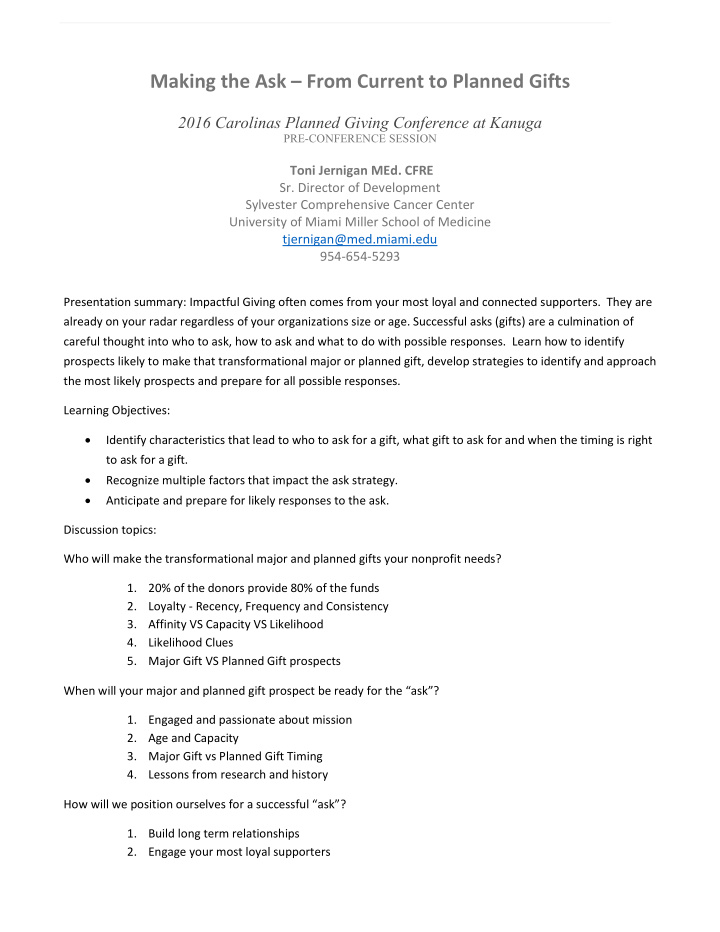



Making the Ask – From Current to Planned Gifts 2016 Carolinas Planned Giving Conference at Kanuga PRE-CONFERENCE SESSION Toni Jernigan MEd. CFRE Sr. Director of Development Sylvester Comprehensive Cancer Center University of Miami Miller School of Medicine tjernigan@med.miami.edu 954-654-5293 Presentation summary: Impactful Giving often comes from your most loyal and connected supporters. They are already on your radar regardless of your organizations size or age. Successful asks (gifts) are a culmination of careful thought into who to ask, how to ask and what to do with possible responses. Learn how to identify prospects likely to make that transformational major or planned gift, develop strategies to identify and approach the most likely prospects and prepare for all possible responses. Learning Objectives: Identify characteristics that lead to who to ask for a gift, what gift to ask for and when the timing is right to ask for a gift. Recognize multiple factors that impact the ask strategy. Anticipate and prepare for likely responses to the ask. Discussion topics: Who will make the transformational major and planned gifts your nonprofit needs? 1. 20% of the donors provide 80% of the funds 2. Loyalty - Recency, Frequency and Consistency 3. Affinity VS Capacity VS Likelihood 4. Likelihood Clues 5. Major Gift VS Planned Gift prospects When will your major and planned gift prospect be ready for the “ask”? 1. Engaged and passionate about mission 2. Age and Capacity 3. Major Gift vs Planned Gift Timing 4. Lessons from research and history How will we position ourselves for a successful “ask” ? 1. Build long term relationships 2. Engage your most loyal supporters
3. Identify top major gift and planned gift prospects 4. Budget for a cultivation and solicitation plan 5. Schedule regular team strategy meetings 6. Keep having the conversations- practice makes perfect 7. Tell passionate stories with simple gift language Conclusions: Major and Planned gifts give your most loyal donors the power to make a transformational impactful on your mission Cultivation for large gifts is a continuing process that may take considerable time to bear fruit Large gifts require an upfront commitment of time and resources from board, administration and staff Extent of upfront commitment and planning will dictate success and timing of results Success is dependent on the organization having a well communicated, compelling charitable purpose and need for substantial financial resources Activities: Group activity to define segments for your type and size organization Group activity to identify and list donor types and characteristics Resources and References: AFP Resources: The Association of Fundraising Professionals (AFP) represents more than 30,000 members in over 230 chapters throughout the world, working to advance philanthropy through advocacy, research, education and certification programs. The association fosters development and growth of fundraising professionals and promotes high ethical standards in the fundraising profession. Resources are available at AFPnet.org. Donor Bill of Rights Code of Ethical Standards PPP Resources: The Partnership for Philanthropic Planning is the source for education, research and advocacy for professionals who have a role in designing and implementing donors’ philanthropic plans. Resources at PPPnet.org include best practices and model documents. Model Standards of Practice for the Charitable Gift Planner Sample Long-Term (Endowment) Gift Agreements Gift Acceptance Policy: ABC Charity Model Bequest Language Confidential Letter of Intent NCPP Presentations: Presentations and conference papers from the National Conference on Philanthropic Planning organized by the Partnership for Philanthropic Planning. The Bequest Pipeline-How Wide? How Long? How Strong? Melissa C. Mencotti, National Conference on Philanthropic Planning 2013 Minneapolis, MN
I Don’t Know Anything about You, But…How to Suggest Planned Gifts into a Donor Conversation. Pamela J Davidson, National Conference on Philanthropic Planning 2014 Anaheim, CA The ABC’s of Major and Planned Gift Portfolio Management, Linda Speed and Kelly Wesley Taylor, National Conference on Philanthropic Planning 2014 Anaheim, California Who Dat?: How to Identify and Market Planned Gifts. Katherine E. Swank, National Conference on Philanthropic Planning 2012 New Orleans, LA Blended Gift, Eh? Making the Most of This Emerging Workhorse for Major and Planned Gift Officers. Ashley A Buderus and Gordon P. Smith, National Conference on Philanthropic Planning 2013 Minneapolis, MN Building a Legacy Gift Portfolio from Your Annual Donor Base. Bruce Makous, National Conference on Philanthropic Planning 2011 San Antonio, TX Notes:
Worksheet: Define your segments A - High capacity and high affinity B – High capacity and low affinity C – Low capacity and high affinity D – Low capacity and low affinity
Recommend
More recommend